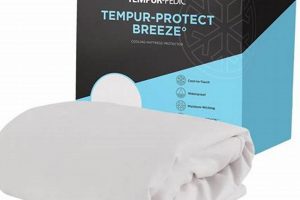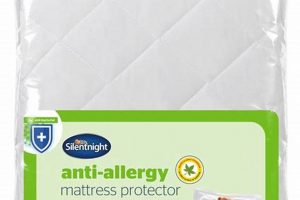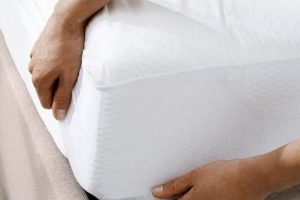The process of cleaning a mattress encasement focuses on maintaining hygiene and extending the lifespan of both the protector and the underlying mattress. Proper execution of this procedure removes allergens, dust mites, and other contaminants that accumulate over time. For example, regular washing prevents the buildup of stains and odors, contributing to a healthier sleeping environment.
Adhering to a consistent cleaning schedule offers several key advantages. It safeguards the mattress from spills and accidents, which can cause permanent damage. Furthermore, a clean encasement promotes better air quality and reduces the risk of allergic reactions. Historically, efforts to protect mattresses have evolved from simple coverings to specialized, washable fabrics, reflecting an increasing awareness of hygiene and comfort.
The following sections detail specific methods for laundering these items, covering pre-wash preparations, washing machine settings, drying techniques, and stain removal strategies to ensure optimal results and longevity.
Effective Strategies for Laundering Mattress Encasements
Maintaining the cleanliness of mattress encasements is essential for preserving their protective qualities and ensuring a hygienic sleep environment. The following guidelines offer practical advice for optimal cleaning results.
Tip 1: Consult Manufacturer Instructions: Prior to initiating any cleaning process, meticulously review the manufacturer’s care label. Adherence to specified washing temperatures and drying methods is crucial for preventing damage or shrinkage.
Tip 2: Pre-Treat Stains: Address any visible stains with a stain remover specifically formulated for the fabric of the encasement. Apply the solution directly to the affected area and allow it to sit for the recommended time before washing.
Tip 3: Use Gentle Detergent: Opt for a mild, hypoallergenic laundry detergent to avoid irritating sensitive skin or damaging the encasement’s fibers. Harsh chemicals can degrade the material over time.
Tip 4: Wash in Cold Water: Unless otherwise indicated by the manufacturer, cold water is generally preferable for laundering mattress encasements. It helps prevent color fading and minimizes the risk of shrinkage.
Tip 5: Avoid Fabric Softeners and Bleach: Refrain from using fabric softeners or bleach, as these substances can compromise the water-resistant or waterproof properties of the encasement.
Tip 6: Tumble Dry on Low Heat: When machine drying is permissible, select a low heat setting to prevent shrinkage or warping. Remove the encasement promptly once dry to minimize wrinkling.
Tip 7: Ensure Complete Drying: Before replacing the encasement on the mattress, verify that it is completely dry. Residual moisture can promote the growth of mold and mildew.
Consistent adherence to these guidelines will prolong the lifespan of mattress encasements, ensuring sustained protection and hygiene.
Following the appropriate steps to ensure proper laundering culminates in enhanced protection and a cleaner sleeping space.
1. Check the label.
The initial step in proper mattress protector maintenance involves scrutinizing the manufacturer’s label. This action is paramount to ensure the chosen cleaning method aligns with the specific fabric composition and construction of the protector, thereby preventing damage and preserving its protective qualities. Failure to heed these instructions can result in diminished performance or irreversible harm to the product.
- Fabric Composition and Temperature Sensitivity
Different materials react differently to heat. Natural fibers like cotton may tolerate higher temperatures, while synthetic materials such as polyurethane or polyester may degrade or melt under excessive heat. The label specifies the maximum permissible washing and drying temperatures, crucial for preventing shrinkage, warping, or loss of waterproof characteristics. Disregarding these temperature recommendations can significantly shorten the protector’s lifespan and compromise its ability to safeguard the mattress.
- Detergent Restrictions and Chemical Sensitivities
Certain mattress protectors incorporate specialized coatings or laminates to enhance their water resistance or allergen-blocking capabilities. The care label often advises against the use of harsh detergents, bleach, or fabric softeners, as these chemicals can strip away protective layers or degrade the fabric fibers. Using recommended detergents ensures that the protector retains its functional properties and avoids potential skin irritation for the user. For example, using bleach on a protector with a waterproof membrane can cause the membrane to disintegrate.
- Washing Machine and Dryer Settings
The label often indicates the appropriate washing machine cycle (e.g., gentle, delicate, normal) and dryer setting (e.g., low, medium, air dry). Using an overly aggressive wash cycle can damage the protector’s seams or cause pilling of the fabric. Similarly, high heat drying can lead to shrinkage or warping. Adhering to the specified settings ensures that the protector is cleaned effectively without compromising its structural integrity. For instance, a delicate cycle minimizes agitation, preventing damage to the protector’s waterproof layer.
- Specific Washing Instructions or Warnings
Some mattress protectors may require unique washing procedures, such as washing separately or inside out. The care label provides these specific instructions to address the protector’s unique design or material properties. Furthermore, warnings against ironing or dry cleaning may be included to prevent damage from extreme heat or chemicals. Ignoring these instructions can lead to irreversible damage and void the product’s warranty.
In conclusion, carefully examining and adhering to the manufacturer’s care label is an indispensable step in properly laundering a mattress protector. This diligence ensures effective cleaning while preserving the protector’s performance, longevity, and the hygiene of the sleep environment.
2. Pre-treat stains carefully.
The meticulous pre-treatment of stains represents a critical step in the comprehensive process of laundering a mattress protector. Addressing stains before the main wash cycle significantly improves the likelihood of complete removal, thereby preserving the material integrity and hygienic qualities of the protector.
- Stain Identification and Appropriate Solution Selection
Effective pre-treatment begins with accurate identification of the stain’s nature. Different types of stains, such as those from bodily fluids, food spills, or ink, require specific pre-treatment solutions. Employing an inappropriate solution may either fail to remove the stain or, worse, set it permanently into the fabric. For instance, enzymatic cleaners excel at breaking down organic stains, while solvent-based solutions are more effective on oil-based stains. Choosing the correct pre-treatment agent is crucial for maximizing stain removal success.
- Gentle Application and Fabric Sensitivity
Mattress protectors often consist of delicate materials, including waterproof membranes or specialized coatings. Applying pre-treatment solutions too aggressively can damage these components. A gentle approach, such as blotting rather than rubbing, minimizes the risk of abrasion or degradation. Furthermore, testing the chosen solution on an inconspicuous area of the protector before widespread application helps to assess its compatibility with the fabric and prevent discoloration or other adverse effects.
- Appropriate Soak Time and Agitation Control
The duration of pre-treatment soaking plays a significant role in stain removal efficacy. Allowing the solution sufficient time to penetrate the stain is essential for loosening its grip on the fabric fibers. However, prolonged soaking or excessive agitation can weaken the material or damage its waterproof properties. Adhering to the pre-treatment product’s recommended soak time and employing gentle agitation techniques ensures optimal stain removal without compromising the protector’s integrity. Overly vigorous rubbing can also damage the fabric or spread the stain further.
- Integration with Overall Washing Procedure
The pre-treatment process must seamlessly integrate with the subsequent washing cycle. Ensuring that all pre-treatment residue is thoroughly rinsed before placing the protector in the washing machine prevents potential interactions with the detergent, which could hinder cleaning effectiveness or cause fabric damage. The washing machine and dryer settings should always follow manufacturers recommendation as stated previously.
In summary, careful stain pre-treatment is an indispensable aspect of maintaining mattress protectors. By identifying the stain accurately, selecting an appropriate solution, applying it gently, and integrating the process with the subsequent wash cycle, one can maximize stain removal success while preserving the protector’s integrity and extending its lifespan.
3. Use gentle detergent.
The selection of appropriate cleaning agents is paramount when laundering a mattress protector. The phrase “Use gentle detergent” underscores a critical consideration for maintaining the integrity and functionality of these protective items. The implications of this directive extend to material preservation, hypoallergenic properties, and overall hygiene.
- Preservation of Fabric Integrity
Aggressive detergents often contain harsh chemicals, such as enzymes, brighteners, and strong surfactants. These substances, while effective at removing stains, can degrade the delicate fibers and protective coatings commonly found in mattress protectors. Gentle detergents, conversely, are formulated with milder surfactants and fewer additives, minimizing the risk of damage. This preservation extends the lifespan of the protector, ensuring it continues to safeguard the mattress effectively.
- Maintenance of Hypoallergenic Properties
Many mattress protectors are designed to provide a barrier against allergens like dust mites and pet dander. Harsh detergents can leave behind residues that irritate sensitive skin or trigger allergic reactions. Gentle, hypoallergenic detergents are formulated to rinse cleanly, minimizing the potential for residue buildup. This is particularly important for individuals with allergies or asthma, as it contributes to a healthier sleep environment.
- Protection of Waterproof or Water-Resistant Membranes
A significant number of mattress protectors incorporate waterproof or water-resistant membranes, often made of polyurethane or similar materials. Harsh detergents can compromise the integrity of these membranes, leading to cracking, peeling, or a loss of their protective properties. Gentle detergents are less likely to cause this type of damage, helping to maintain the effectiveness of the waterproof barrier.
- Environmental Considerations
Gentle detergents are often more environmentally friendly than their harsh counterparts. They typically contain biodegradable surfactants and fewer phosphates, reducing their impact on waterways and ecosystems. Choosing a gentle detergent aligns with a commitment to sustainability while ensuring the effective cleaning of a mattress protector.
The imperative to “Use gentle detergent” when laundering a mattress protector is not merely a suggestion but a crucial element in preserving its function, prolonging its lifespan, and ensuring a healthy sleep environment. The selection of an appropriate cleaning agent directly impacts the protector’s material integrity, hypoallergenic properties, and the effectiveness of its waterproof barrier. Therefore, adherence to this principle is essential for maintaining the investment in a quality mattress protector.
4. Cold water preferred.
The directive “Cold water preferred” represents a key recommendation in the context of mattress protector care. This preference is not arbitrary; it stems from several material science and practical considerations that directly influence the protector’s lifespan, functionality, and the overall hygiene of the sleeping environment. Implementing cold water washing as a component will ensure longevity.
One primary reason for the preference for cold water washing is the minimization of fabric shrinkage. High temperatures can cause certain materials, particularly cotton and some synthetic blends, to contract. Mattress protectors are designed to fit snugly around the mattress; significant shrinkage renders them ineffective and necessitates premature replacement. Cold water washing mitigates this risk. Furthermore, cold water is gentler on delicate components such as waterproof membranes and laminated layers, preventing their degradation and preserving their protective qualities. Certain stain removal processes are also enhanced with the use of cold water, preventing stains from setting.
The adoption of cold water washing practices also contributes to energy conservation, decreasing the environmental footprint associated with laundering. Despite potential concerns about cleaning effectiveness, modern cold water detergents are formulated to deliver comparable cleaning power to their warm or hot water counterparts. It is paramount to choose detergents specifically designed for cold water use to ensure satisfactory stain removal and overall cleanliness. The implementation of this recommendation is a critical component of a responsible cleaning process.
5. Avoid bleach/softeners.
The instruction to “Avoid bleach/softeners” is a crucial directive within the framework of proper mattress protector maintenance. The chemicals contained within these substances can interact negatively with the materials used in the protector’s construction, leading to diminished performance and premature degradation. Chlorinated bleach, a potent oxidizing agent, can weaken fabric fibers, particularly natural materials such as cotton. Continued exposure results in thinning of the material, compromising its ability to provide a protective barrier. Similarly, bleach can damage waterproof or water-resistant coatings, rendering them ineffective at preventing liquid penetration. These coatings, often composed of polyurethane or similar polymers, are susceptible to chemical degradation from bleach exposure. For example, frequent washing with bleach will cause a waterproof mattress protector to lose its waterproof properties over time, negating its primary function.
Fabric softeners, while imparting a desirable tactile feel, can also negatively impact mattress protectors. These products deposit a coating on fabric fibers, which, over time, can reduce breathability and trap allergens. This coating can also interfere with the wicking properties of some protectors, hindering their ability to draw moisture away from the sleeper. This reduction in breathability contributes to discomfort and potentially promotes the growth of mold and mildew. Furthermore, the coating left by fabric softeners can diminish the effectiveness of any water-resistant or waterproof membranes, as it creates a barrier that prevents them from functioning optimally. A real-world example could be a quilted protector becoming lumpy and losing its shape due to softener build-up in the fill.
Adhering to the “Avoid bleach/softeners” instruction is, therefore, not merely a preference but a critical step in preserving the functionality, longevity, and hygienic qualities of a mattress protector. Understanding the potential damage caused by these substances enables informed decisions regarding laundry practices. By opting for gentler alternatives, such as mild detergents and natural fabric softeners (e.g., vinegar), one can effectively clean and maintain the protector without compromising its protective properties or the comfort of the sleeping environment. Ultimately, recognizing and implementing this guidance is key to safeguarding the investment in a quality mattress protector.
6. Low heat drying.
The process of drying mattress protectors, particularly utilizing reduced temperatures, plays a critical role in maintaining their integrity and prolonging their lifespan. Employing low heat drying techniques directly relates to how a mattress protector is effectively cleaned and maintained.
- Preservation of Material Integrity
High heat can cause irreversible damage to the delicate fibers and waterproof membranes commonly found in mattress protectors. These components, often made of synthetic materials, are susceptible to melting, warping, or cracking under excessive heat. Low heat drying minimizes this risk, allowing the protector to retain its original shape and functionality. For example, a protector dried on high heat may shrink, rendering it unusable or causing the waterproof membrane to become brittle and prone to tearing.
- Prevention of Waterproof Membrane Degradation
Many mattress protectors feature a waterproof or water-resistant layer, typically made of polyurethane or a similar material. Elevated temperatures can degrade these membranes, compromising their ability to prevent liquid penetration. Low heat drying helps preserve the integrity of the waterproof layer, ensuring that the protector continues to safeguard the mattress from spills and accidents. A protector subjected to high heat drying may experience a breakdown of its waterproof properties, leading to moisture seeping through to the mattress.
- Minimization of Shrinkage and Distortion
Mattress protectors are designed to fit snugly over the mattress. High heat drying can cause the fabric to shrink, resulting in a protector that is too small to properly cover the mattress. Additionally, uneven heating can lead to distortion, causing the protector to lose its shape. Low heat drying reduces the likelihood of shrinkage and distortion, ensuring a proper fit and consistent performance. For example, a cotton blend protector dried on high heat might shrink significantly, becoming difficult or impossible to stretch over the mattress.
- Energy Conservation and Environmental Impact
Lowering the dryer temperature reduces energy consumption, contributing to a smaller environmental footprint. While high heat drying may seem faster, the benefits of preserving the protector and conserving energy outweigh the marginal time savings. Choosing a low heat setting demonstrates a commitment to sustainability without compromising the effectiveness of the cleaning process. The energy saved from using a low heat setting adds up over the lifespan of the protector, contributing to lower utility bills and a reduced environmental impact.
The integration of “Low heat drying” into the overall process significantly impacts how mattress protectors are handled. The careful consideration of drying temperatures is a vital component in maintaining the integrity and extending the lifespan of mattress protectors, thereby safeguarding the underlying mattress and promoting a hygienic sleeping environment.
7. Complete drying vital.
The phrase “Complete drying vital” represents a critical, often overlooked, aspect of the laundering process for mattress protectors. While proper washing removes contaminants, inadequate drying nullifies those efforts, potentially leading to significant hygiene and material integrity issues. The connection between complete drying and the overarching process is one of cause and effect. Insufficient drying creates an environment conducive to microbial growth, negating the benefits of washing. For example, a protector left damp can harbor mold and mildew, leading to unpleasant odors and potential allergic reactions. Therefore, ensuring the item is fully dry is an indispensable component of maintaining a healthy sleep environment.
Further illustrating the practical significance of this step, consider the materials often used in protector construction. Waterproof membranes, while effective at preventing liquid penetration, can trap moisture within the fabric if not properly dried. This trapped moisture creates an ideal breeding ground for bacteria and fungi. Moreover, residual dampness can degrade the waterproof layer over time, diminishing its protective capabilities. From an application standpoint, rotating protectors allows for sufficient drying time, particularly in humid climates. Furthermore, utilizing fans or dehumidifiers in the drying area can expedite the process and ensure thorough moisture removal.
In summary, the importance of complete drying extends beyond mere convenience; it is intrinsically linked to the effectiveness of the entire mattress protector cleaning process. While challenges such as time constraints or inadequate drying equipment may exist, the consequences of incomplete drying microbial growth, material degradation, and compromised hygiene outweigh the perceived benefits of a rushed process. The emphasis on “Complete drying vital” underscores the need for diligence and thoroughness in every stage of mattress protector care.
Frequently Asked Questions
The following questions address common inquiries regarding the proper laundering of mattress protectors. Adherence to these guidelines ensures optimal hygiene and prolongs the lifespan of the product.
Question 1: How frequently should a mattress protector be laundered?
The recommended laundering frequency for a mattress protector is typically every one to two months. More frequent washing may be necessary if spills or accidents occur.
Question 2: Can a mattress protector be washed with other bedding items?
Mattress protectors can generally be washed with other bedding items, provided that the care instructions for all items are compatible. It is advisable to avoid washing with items that have zippers or other fasteners that could potentially damage the protector’s surface.
Question 3: What type of detergent is best suited for washing a mattress protector?
A mild, hypoallergenic detergent is generally recommended. Harsh detergents containing bleach or strong chemicals should be avoided, as these can damage the protector’s waterproof membrane or other protective coatings.
Question 4: Is it necessary to pre-treat stains on a mattress protector?
Pre-treating stains is advisable, particularly for spills or accidents involving bodily fluids or food. A stain remover specifically formulated for the fabric of the protector should be applied to the affected area prior to washing.
Question 5: What is the recommended drying method for a mattress protector?
Tumble drying on low heat is generally recommended. High heat can cause shrinkage or damage to the protector’s waterproof membrane. Air drying is also an option, provided that the protector is thoroughly dried to prevent the growth of mold or mildew.
Question 6: How can the waterproof membrane of a mattress protector be preserved during washing?
To preserve the waterproof membrane, avoid using bleach, fabric softeners, or high heat during washing and drying. Gentle detergents and low heat drying are essential for maintaining the integrity of the membrane.
Proper adherence to these guidelines ensures effective cleaning and maximizes the lifespan of mattress protectors.
Considerations for specific stain removal techniques will be discussed in the subsequent section.
Concluding Remarks on Mattress Protector Laundering
The preceding examination has elucidated critical aspects of how to wash mattress protector. Emphasized points include the careful selection of detergents, the judicious use of temperature, stain pre-treatment protocols, and the vital importance of complete drying. Proper execution of these steps is paramount to maintaining the protector’s integrity and safeguarding the underlying mattress.
Effective implementation of these guidelines will not only extend the lifespan of the mattress protector but also contribute significantly to a cleaner, healthier sleep environment. Consistent adherence to recommended practices represents a proactive investment in both hygiene and the longevity of bedding materials, which impacts personal health and financial stability.



![Best Malouf Mattress Protector [Guide & Review] Organic & Natural Mattress Buyer’s Guide: Non-Toxic Sleep Solutions Best Malouf Mattress Protector [Guide & Review] | Organic & Natural Mattress Buyer’s Guide: Non-Toxic Sleep Solutions](https://mattressworldpa.com/wp-content/uploads/2025/07/th-2531-300x200.jpg)
![Best Purple Protector Mattress: [Benefit] & Protection! Organic & Natural Mattress Buyer’s Guide: Non-Toxic Sleep Solutions Best Purple Protector Mattress: [Benefit] & Protection! | Organic & Natural Mattress Buyer’s Guide: Non-Toxic Sleep Solutions](https://mattressworldpa.com/wp-content/uploads/2025/07/th-2530-300x200.jpg)


